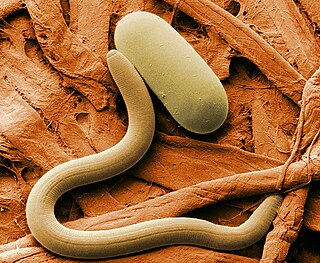
Arenaria is a genus of flowering plants, within the family Caryophyllaceae.

Meloidogyne arenaria is a species of plant pathogenic nematodes. This nematode is also known as the peanut root knot nematode. The word "Meloidogyne" is derived from two Greek words that mean "apple-shaped" and "female". The peanut root knot nematode, M. arenaria is one of the "major" Meloidogyne species because of its worldwide economic importance. M. arenaria is a predominant nematode species in the United States attacking peanut in Alabama, Florida, Georgia, and Texas. The most damaging nematode species for peanut in the USA is M. arenaria race 1 and losses can exceed 50% in severely infested fields. Among the several Meloidogyne species that have been characterized, M. arenaria is the most variable both morphologically and cytologically. In 1949, two races of this nematode had been identified, race 1 which reproduces on peanut and race 2 which cannot do so. However, in a recent study, three races were described. López-Pérez et al (2011) had also studied populations of M. arenaria race 2, which reproduces on tomato plants carrying the Mi gene and race 3, which reproduces on both resistant pepper and tomato.
Heterodera cajani is a plant pathogenic nematode affecting pigeonpeas, who is cited as an invasive species.
Heterodera gambiensis is a plant pathogenic nematode affecting pearl millet.
Heterodera latipons, the Mediterranean cereal cyst nematode or wheat cyst nematode, is a plant pathogenic nematode.
Heterodera rosii is a plant pathogenic nematode that attacks chickpea.

Heterodera schachtii, the beet cyst eelworm or sugarbeet nematode, is a plant pathogenic nematode. It infects more than 200 different plants including economically important crops such as sugar beets, cabbage, broccoli, and radish. H. schachtii is found worldwide. Affected plants are marked by stunted growth, wilting, yellowing, decreased yields, and death. While there are many methods of control, crop rotation with non-susceptible plants is preferred.

Heterodera is a genus of nematodes in the family Heteroderidae. Members of the genus are obligate parasites and different species attack different crops, often causing great economic damage. The genus is unique among nematode genera because of the ability of the female to transform into a tough, brown, cyst which protects the eggs which have been formed within her body. The name heterodera "refers to the different 'skins' of female and cyst."
Heterodera amygdali is a plant pathogenic nematode native to Tajikistan.
Cereal cyst nematode (CCN) is a plant pest caused by Heterodera avenae, Heterodera bifenestra, Heterodera hordecalis, Heterodera latipons, and Heterodera gotland in the following hosts: Avena sativa, Hordeum vulgare, Secale cereale, Triticum aestivum, and × Triticosecale.
Heterodera bifenestra is a plant pathogenic nematode, that is a causal agent of the cereal cyst nematode.
Heterodera canadensis is a plant pathogenic nematode.
Heterodera cardiolata is a plant pathogenic nematode.
Heterodera oryzae, the rice cyst nematode, is a plant pathogenic nematode, which is cited as an invasive species.
Heterodera oryzicola, the rice cyst nematode, is a plant pathogenic nematode, which is cited as an invasive species.
Heterodera delvii is a plant pathogenic nematode, who is cited as an invasive species.
H. arenaria may refer to:
Pasteuria nishizawae is a mycelial and endospore-forming bacterium parasitic on cyst nematodes of genera Heterodera and Globodera.

Epicauta heterodera is a species of blister beetle in the family Meloidae. It is found in North America.




